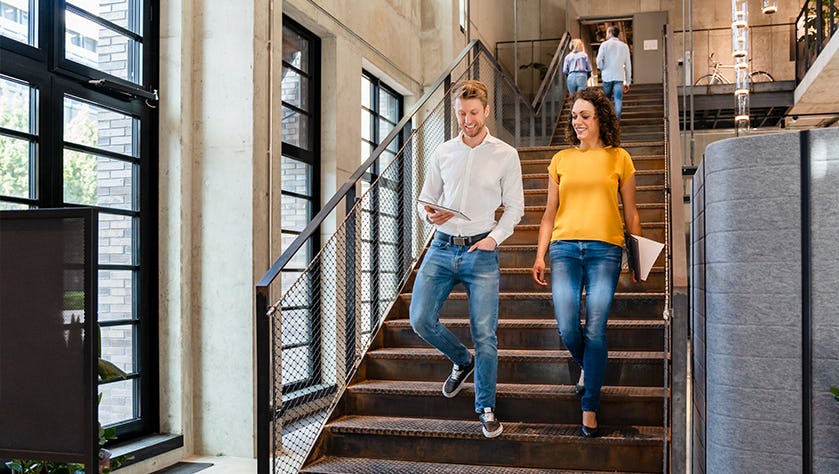
We sit too much and it’s bad for our health – two facts that are becoming increasingly hard to ignore. So how do you get the work done and encourage staff to be active? Hybrid working and Zoom aerobics might be part of the answer.
There was a time, not so long ago, that people laughed at the thought of a standing desk. When lunchtime runners were in the minority and when, if we only stood up every few hours to make a cup of tea, then that was perfectly ok too. But in all the various health data that filters through and fades away, the risks associated with a sedentary lifestyle, and specifically with too much sitting, have held firm, and those standing desks that were so funny, now seem like a pretty good idea.
A report by Stanford University found that people who work from home all of the time sit for around 9.2 hours a day, compared to 7.3 hours for those who cannot work from home at all. It seems that without the base level of movement that comes from even a short commute to the office, many people have little or no reason to move much further than their sofa. But then travelling into an office everyday isn’t ideal either. Squashing into a train carriage with a hundred strangers was never fun, but it feels particularly alien in this post-Covid world.
It seems the move towards hybrid working, and offices that are within walking or cycling distance from home, is at least part of the answer. But what else can you and your team do to switch up routines and reduce sedentary hours?
Share the tough facts
Giving people the information and the opportunity to change their activity levels is arguably the first and most important step. Sitting for too long is thought to slow the metabolism, affecting the body’s ability to regulate blood sugar, blood pressure and break down body fat. Long periods of inactivity have also been proven to have negative effects on mental health. Furnishing staff with the grim facts is an important first step in combating our collective stillness.
Considering activity levels purely through the cold eyes of productivity and professional output has the same message. Active people are more creative and inventive than sedentary ones, according to researchers at Austria’s University of Graz.
Embrace the behavioural changes
Yes, there are those standing desks as well as active sitting chairs that encourage more movement and improved posture. But there are also behavioural changes to be made. Hybrid working means people still get the action of a commute two or three times a week, but it is balanced with more time at home for exercise and reduced travelling stress. The same Stanford University paper mentioned above, suggests that work meetings longer than 30 minutes could incorporate breaks for standing, walking, or movement.
It also suggests that some remote meetings should be carried out without video, so that people can take part while they are walking or standing outside (or on an exercise bike, or a treadmill, or doing squats in the home gym). Staff should be encouraged to use the stairs rather than lifts, the report adds, and exercise equipment such as dumbbells or yoga mats should all be readily accessible for people to use, in case the whim takes them.
Many companies already enable lunchtime or early morning group fitness sessions. Yoga in an empty meeting room, or a Zoom aerobics session not only gives staff the opportunity to move, but it also fosters an attitude that carving out time for exercise within the working day is okay – and more than that, encouraged. There are other benefits too. When employees know that their bosses care about their wellbeing, trust and loyalty also increases.
From tech to triathlons
Technology also has a role to play here. Wearable fitness devices such as watches, can monitor sedentary behaviour and alert people, with an alarm or a vibration, to stand up and move around if they have been inactive for too long. ‘Gamifying’ exercise can even make it fun. Competitions between colleagues, with point scoring and leaderboards, or setting collective fitness goals, can have the added benefit of encouraging team bonding. An entirely remote team could, for example, meet up for social sporting events such as mud runs or triathlon relays, having spent weeks training together and supporting each other online.
There are plenty of ways to incorporate movement into the working day, but the most important responsibility for employers may lie in providing the time for it. Allowing and encouraging staff to take a few moments each day to be away from their computer screens is one of the most simple – and effective – tools at any manager’s disposal.
Providing the opportunity for hybrid work is a vital part of this equation, because the very nature of hybrid provides extra time, flexibility and freedom to workers, so they can indeed incorporate changes to their routine that make them more active. When employees are trusted to shape their work patterns, positive change is allowed to happen.
This mentality shift, combined with modern, thoughtfully furnished offices (with those readily accessible yoga mats) make up a large part of the mission. And this should be a mission, because a less sedentary workforce is not only good for business, it also makes a positive difference to people’s lives.
Start your search for an active and inspiring workspace where your staff can thrive by browsing our offices and locations.
Share this article
 Read now Building a community: How to reduce work anxiety for you and your team
Read now Building a community: How to reduce work anxiety for you and your team
 Read now Goodbye to the beanbags: Why the office needs to grow up
Read now Goodbye to the beanbags: Why the office needs to grow up